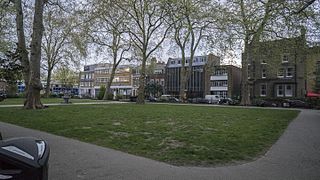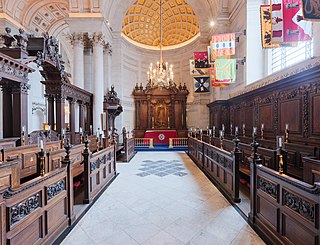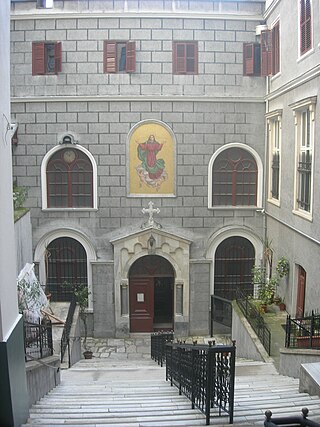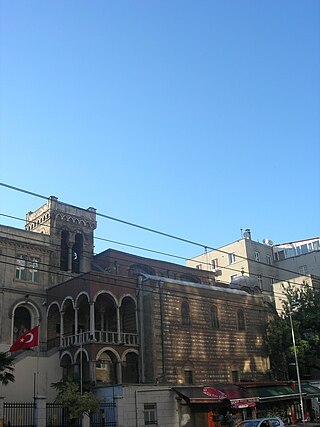
Hoxton is an area in the London Borough of Hackney, England. As a part of Shoreditch, it is often considered to be part of the East End – the historic core of wider East London. It was historically in the county of Middlesex until 1889. It lies immediately north of the City of London financial district, and was once part of the civil parish and subsequent Metropolitan Borough of Shoreditch, prior to its incorporation into the London Borough of Hackney.

Early modern Europe, also referred to as the post-medieval period, is the period of European history between the end of the Middle Ages and the beginning of the Industrial Revolution, roughly the late 15th century to the late 18th century. Historians variously mark the beginning of the early modern period with the invention of moveable type printing in the 1450s, the Fall of Constantinople and end of the Hundred Years’ War in 1453, the end of the Wars of the Roses in 1485, the beginning of the High Renaissance in Italy in the 1490s, the end of the Reconquista and subsequent voyages of Christopher Columbus to the Americas in 1492, or the start of the Protestant Reformation in 1517. The precise dates of its end point also vary and are usually linked with either the start of the French Revolution in 1789 or with the more vaguely defined beginning of the Industrial Revolution in late 18th century England.

In English church history, Nonconformists were Protestant Christians who did not "conform" to the governance and usages of the state church, the Church of England.

A chapel is a Christian place of prayer and worship that is usually relatively small. The term has several meanings. First, smaller spaces inside a church that have their own altar are often called chapels; the Lady chapel is a common type of these. Second, a chapel is a place of worship, sometimes non-denominational, that is part of a building, complex, or vessel with some other main purpose, such as a school, college, hospital, palace or large aristocratic house, castle, barracks, prison, funeral home, cemetery, airport, or a military or commercial ship. Third, chapels are small places of worship, built as satellite sites by a church or monastery, for example in remote areas; these are often called a chapel of ease. A feature of all these types is that often no clergy were permanently resident or specifically attached to the chapel.

George Calvert, 1st Baron Baltimore, was an English politician and colonial administrator. He achieved domestic political success as a member of parliament and later Secretary of State under King James I. He lost much of his political power after his support for a failed marriage alliance between Prince Charles and the Spanish House of Habsburg royal family. Rather than continue in politics, he resigned all of his political offices in 1625 except for his position on the Privy Council and declared his Catholicism publicly. He was created Baron Baltimore in the Peerage of Ireland upon his resignation. Baltimore Manor was located in County Longford, Ireland.

Edward Montagu, 1st Earl of Sandwich, KG PC FRS JP was an English military officer, politician and diplomat, who fought for the Parliamentarian army during the First English Civil War and was an MP at various times between 1645 and 1660. A loyal supporter of Oliver Cromwell, he was a member of the English Council of State from 1653 to 1659 and General at sea from 1656 to 1660. Following Cromwell's death in 1658, he switched allegiance and played an important role in the Restoration of Charles II in May 1660.
John Gother, also known as John Goter, was an English convert to Catholicism, priest, controvertist and eirenicist.

St Etheldreda's Church is a Roman Catholic church in Ely Place, off Charterhouse Street in Holborn, London. The building is one of only two surviving in London from the reign of Edward I, and dates from between 1250 and 1290. It is dedicated to Æthelthryth, or Etheldreda, the Anglo-Saxon saint who founded the monastery at Ely in 673. It was the chapel of the London residence of the Bishops of Ely.
The 1583 Throckmorton Plot was one of a series of attempts by English Roman Catholics to depose Elizabeth I of England and replace her with Mary, Queen of Scots, then held under house arrest in England.The alleged objective was to facilitate a Spanish invasion of England, assassinate Elizabeth, and put Mary on the English throne.

The Franco-Ottoman Alliance, also known as the Franco-Turkish Alliance, was an alliance established in 1536 between the King of France Francis I and the Sultan of the Ottoman Empire Suleiman I. The strategic and sometimes tactical alliance was one of the longest-lasting and most important foreign alliances of France, and was particularly influential during the Italian Wars. The Franco-Ottoman military alliance reached its peak around 1553 during the reign Henry II of France.

Morocco–United Kingdom relations are the bilateral relations that exist between the Kingdom of Morocco and the United Kingdom.
The Sardinian Embassy Chapel was an important Catholic church and embassy chapel attached to the Embassy of the Kingdom of Sardinia in the Lincoln's Inn area of London. It was demolished in 1909.

Saint Mary Draperis is a Roman Catholic Church in Istanbul, important for historical reasons. Established in 1584, the church is one of the most ancient Roman Catholic parishes of Istanbul.

Saint Benoit is a Roman Catholic Church in Istanbul, Turkey, important for historical reasons. Established in 1427, the shrine is the oldest Catholic church of Istanbul still in use.

Sir Lewes Lewknor (c.1560–1627) was an English courtier, M.P., writer, soldier, and Judge who served as Master of the Ceremonies to King James I of England. M.P. for Midhurst in 1597 and for Bridgnorth 1604–10. His career has been described as a "tortuous trajectory rich in false starts, byways and rather nebulous interludes...[with] slippery religious and political allegiances".

St James' Church is a large English Gothic Catholic church in George Street, Marylebone, London. Although currently situated in George Street, the church maintains its connection with Spanish Place, the road opposite the current church, because of its historic connection with the Spanish Embassy. It is a Grade II* listed building.

The Embassy of Spain in London is the diplomatic mission of Spain in the United Kingdom. The embassy is located at 24 Belgrave Square in the Belgravia area of London. Spain also maintains a Consulate General at 20 Draycott Place in Chelsea, a Defence Office at 3 Hans Crescent in Knightsbridge, an Education, Employment & Social Affairs Office at 20 Peel Street in Holland Park, and an Economic & Commercial Section at 66 Chiltern Street in Marylebone.

The Church of Our Lady of the Assumption and St Gregory is a Catholic church on Warwick Street, Westminster. It was formerly known as the Royal Bavarian Chapel, because like several Catholic churches in London it originated as a chapel within a foreign embassy. It was built between 1789 and 1790 to the designs of Joseph Bonomi the Elder. The only surviving eighteenth-century Catholic chapel in London, it is a Grade II* listed building. The parish is now operated by the Personal Ordinariate of Our Lady of Walsingham, the British personal ordinariate for the Anglican Use within the Catholic Church.

Antonio Crutta was a diplomat and politician in the Polish court for around 30 years in the reign of Stanisław August Poniatowski. For his services, to the Polish state he was ennobled in 1792.
Lime Street Chapel was a Roman Catholic place of worship in the City of London, in use during a short period of the reign of James II and VII of Great Britain.
















